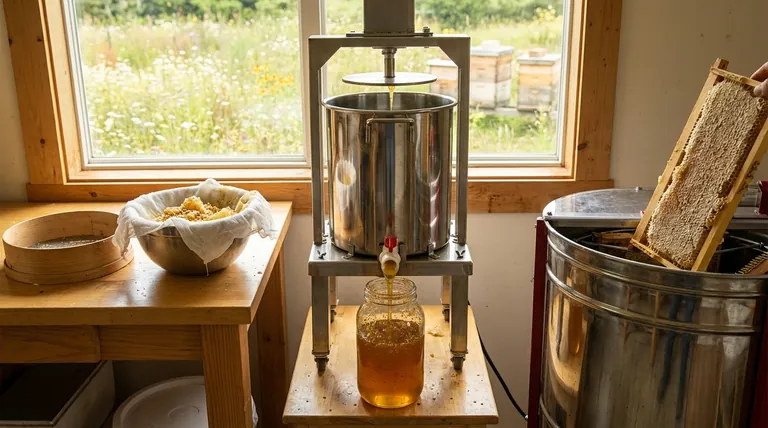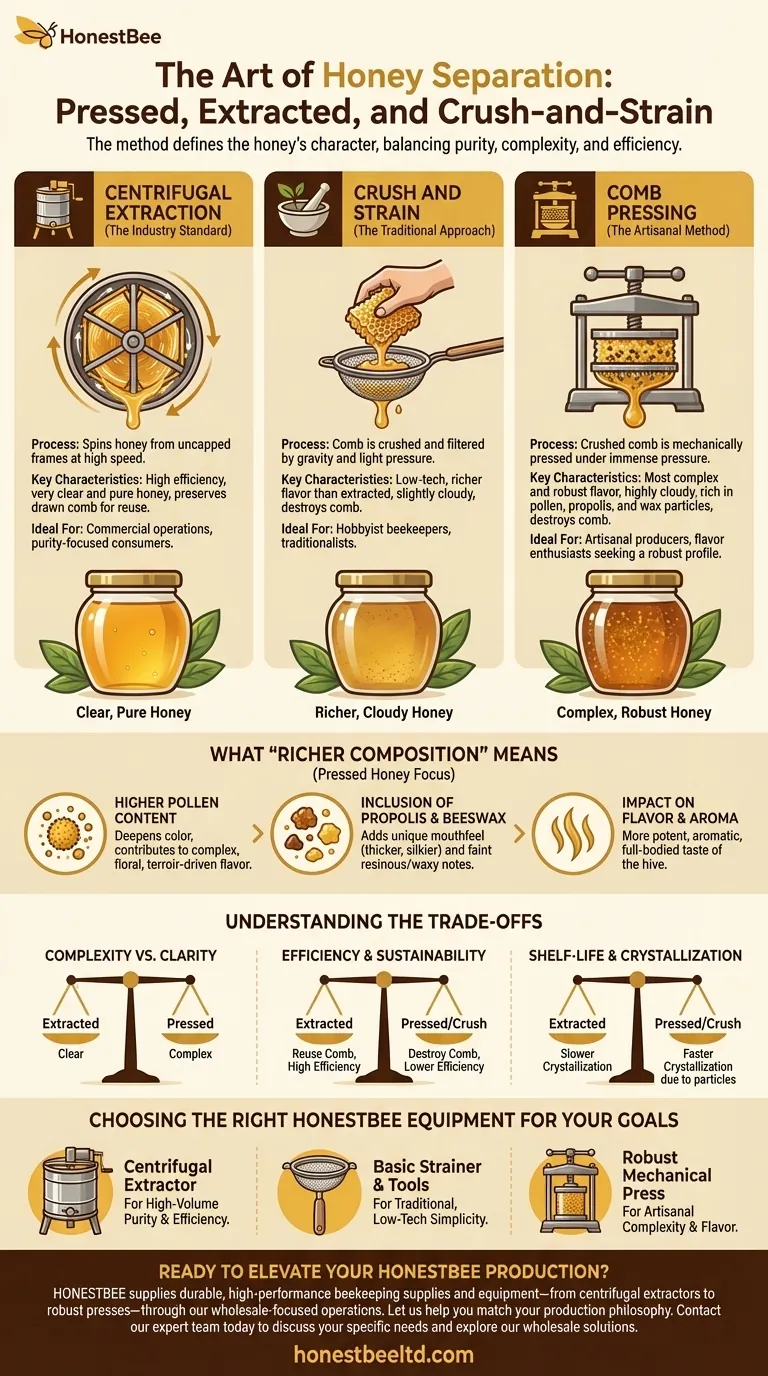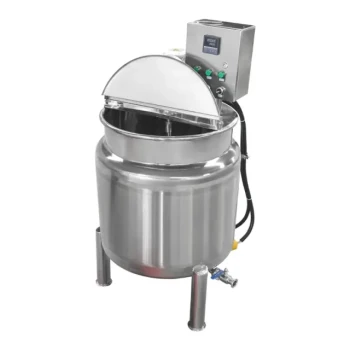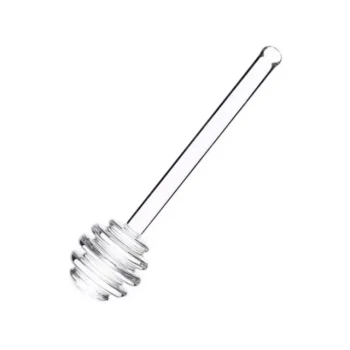When it comes to honey, not all separation methods are created equal. Pressed honey is fundamentally different from centrifugally extracted or crush-and-strain honey due to its composition. The act of pressing the comb incorporates a significantly higher concentration of pollen, propolis, and fine beeswax particles into the final product, resulting in a richer, more complex flavor profile, a cloudier appearance, and a distinct texture.
The method used to separate honey from its comb is not merely a processing detail; it defines the honey's character. While centrifugal extraction prioritizes purity and efficiency, pressing captures a fuller expression of the hive, creating a more complex and robust product.

The Three Methods of Honey Separation
To understand the differences in the final product, you must first understand the process. Each method represents a different philosophy regarding what should be preserved from the hive.
Centrifugal Extraction: The Industry Standard
This is the most common method used by commercial and many hobbyist beekeepers today. Frames of honeycomb are uncapped and placed in a machine called an extractor, which spins them at high speed.
Centrifugal force flings the honey out of the wax cells without destroying the comb. This high-efficiency process yields a very "clean," clear honey and, critically, preserves the drawn-out comb, which can be returned to the bees, saving them immense energy.
Crush and Strain: The Traditional Approach
This is a simpler, more traditional method. The beekeeper cuts the entire comb from the frame, crushes it by hand or with a tool, and places the resulting mixture of wax and honey into a sieve or cloth filter.
Gravity (and sometimes light squeezing) separates the honey from the larger pieces of wax. While it destroys the comb, it's a low-tech method that often yields a honey richer than extracted honey, as more small particles pass through the filter.
Comb Pressing: The Artisanal Method
Pressed honey represents the most intensive and compositionally inclusive method. Like the crush-and-strain method, the comb is first cut from the frame.
However, instead of relying on gravity, the crushed comb is placed into a mechanical press. The immense pressure squeezes out not only the honey but also forces a significant amount of pollen, propolis, and microscopic wax particles from the cells into the final liquid.
What "Richer Composition" Actually Means
The claim that pressed honey is "richer" is not a marketing term; it's a literal description of its contents, which directly impacts its sensory profile.
Higher Pollen Content
A honey press forces a much larger quantity of pollen grains, which are stored in the comb, into the honey. This can deepen the honey's color and contribute to a more complex, floral, and "terroir-driven" flavor that reflects its floral source more intensely.
Inclusion of Propolis and Beeswax
The pressure also incorporates microscopic particles of propolis (a resinous "bee glue") and beeswax. These elements contribute to a unique mouthfeel—often thicker and silkier—and can add faint resinous or waxy notes to the flavor profile, adding layers of complexity.
The Impact on Flavor and Aroma
The combination of more pollen, propolis, and wax results in a fundamentally different product. Think of it like comparing cold-pressed, unfiltered olive oil to a highly refined version; the former is cloudy and robust, while the latter is clear and mild. Pressed honey offers a more potent, aromatic, and full-bodied taste of the hive itself.
Understanding the Trade-offs
Choosing a honey is about understanding the balance between purity, complexity, and production philosophy. No single method is inherently superior; they simply serve different goals.
Complexity vs. Clarity
Centrifugally extracted honey is the benchmark for purity and clarity. It delivers the clean, sweet taste of nectar. Pressed honey sacrifices this clarity for a more complex, "whole-food" product that includes other beneficial hive elements.
Efficiency and Sustainability
Centrifugal extraction is unmatched in efficiency and scalability. Most importantly, it allows beekeepers to reuse the drawn wax comb. Since bees consume roughly 8 pounds of honey to produce 1 pound of wax, preserving the comb is a massive energy-saver for the colony. Pressing and crushing both destroy this vital resource.
Shelf-Life and Crystallization
The higher particulate content (pollen, wax) in pressed and crush-and-strain honey provides more nucleation points for sugar crystals to form. This means these types of honey often crystallize faster than highly filtered, extracted honey. This is a natural process and not a sign of spoilage.
Choosing the Right Honey for Your Palate
The "best" honey is the one that aligns with your specific preferences for flavor, texture, and philosophy.
- If your primary focus is a pure, clear, and classic honey flavor: Centrifugally extracted honey is your ideal choice for its clarity and mildness.
- If your primary focus is experiencing the most complex, robust, and terroir-driven flavor profile: Seek out pressed honey for its rich inclusion of pollen and other hive elements.
- If you are a hobbyist beekeeper or prefer a traditional, low-tech product: The crush-and-strain method offers a great balance between simplicity and a full-flavored honey.
Ultimately, understanding the journey from comb to jar empowers you to appreciate the distinct and deliberate character found in each type of honey.
Summary Table:
| Method | Process | Key Characteristics | Ideal For |
|---|---|---|---|
| Centrifugal Extraction | Spins honey out of frames, preserving comb. | Clear, pure, mild flavor; high efficiency; comb reusable. | Commercial operations, purity-focused consumers. |
| Crush and Strain | Comb is crushed & filtered by gravity. | Richer flavor than extracted; cloudy; destroys comb. | Hobbyist beekeepers, traditionalists. |
| Pressing | Comb is mechanically pressed under high pressure. | Most complex flavor; cloudy; rich in pollen, propolis, wax; destroys comb. | Artisanal producers, flavor enthusiasts seeking a robust profile. |
Ready to Elevate Your Honey Production?
Whether you manage a commercial apiary or are a beekeeping equipment distributor, the right tools define your product's quality and your operational efficiency. HONESTBEE supplies durable, high-performance beekeeping supplies and equipment—from centrifugal extractors for high-volume purity to robust presses for artisanal complexity—through our wholesale-focused operations.
Let us help you choose the perfect equipment to match your production philosophy and meet your customers' demands. Contact our expert team today to discuss your specific needs and explore our wholesale solutions.
Visual Guide

Related Products
- 10L Stainless Steel Electric Honey Press Machine
- Stainless Steel Honey Press Wax Press with Tank
- Stainless Steel Manual Honey Press with Guard for Pressing Honey and Wax
- Electric Flatting and Embossing Machine with Tray for Beekeeping
- Honey Wax Separating Wax Press with Metal Screw Wax Separator Machine
People Also Ask
- What are the main differences between centrifugal extractors and honey presses? A Guide for Commercial Apiaries
- What happens to the wax after pressing in a honey press? A Guide to Maximizing Your Hive's Yield
- What voltage options are available for stainless steel screw honey pumps? Choose the Right Power for Your Scale
- What are the benefits of the screw design in a stainless steel honey pump? Preserve Honey Quality and Integrity
- How does the press method for extracting honey work? A Simple, Low-Cost Guide for Beekeepers



















